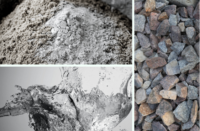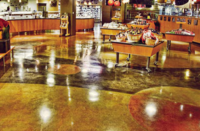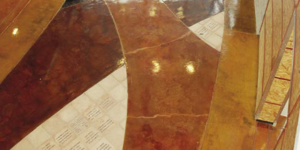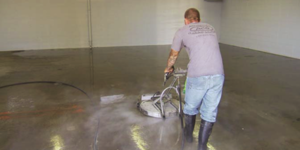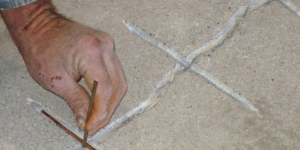
On a regular basis, many of us are asked: “What is the best way to maintain polished concrete?” Is there one method proven to be superior?
In this article, we’ll explore some field-testing reviews and compare traditional DIPs (diamond-impregnated pads) to a newer floor maintenance system involving composite resin abrasives (CRAs).
Defining DIPs and CRAs
According to Stone Sole Associates LLC, DIPs “are produced by spraying, dipping or otherwise applying a diamond-filled resin slurry onto the surface of a lofty, nonwoven pad substrate.”
After being sprayed or dipped, they undergo a thermal curing phase. Product claims for DIPs centralize around the idea that this method is capable of chemical-free cleaning. It is also a common claim that DIPs continuously enhance concrete’s aesthetic surface properties.
CRAs, the newer technology of the two systems, are best described as a “hybrid design integrating a nonwoven, diamond-free cleaning pad with separate, rigid composite diamond elements,” notes Stone Sole Associates. Put in simpler terms, this means the pad’s abrasive portion is made separately from a nonwoven pad, so the composite diamond elements are independent of the pad and not thermally cured to it like DIPs.
Because the composite diamond elements are independent of the pad, it allows the diamonds to act primarily on the exposed high points and pass over the valleys, or low points. Over time, it polishes down the high points and makes a flat planar surface best suited for a clearer, higher-quality, light reflection.
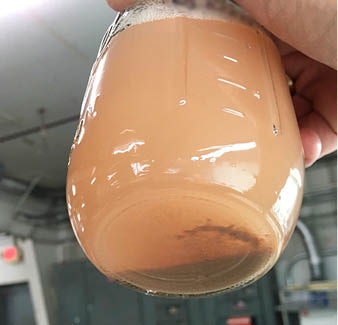
Testing procedure
To determine which pad system offers the superior maintenance solution, Stone Sole Associates compared DIPs and CRAs head-to-head. During this testing, daily maintenance protocols simulated the long-term effects of both pad systems.
Two 126-square-feet sections of highly polished concrete were sectioned off and cleaned with an auto-scrubber using each of the respective maintenance systems. Testing conditions were identical for each cleaning pad: approximately 40 pounds of machine downforce at 80-feet-per-minute forward speed.
It took several days to complete more than 1,000 passes over the floor with each maintenance system. During regular intervals, surface quality measurements were made to check on the effects each system had on the floor with prescribed daily use. The quality measurements used were physical surface roughness (Rk) and aesthetic reflective image quality (distinctness of image or DOI).
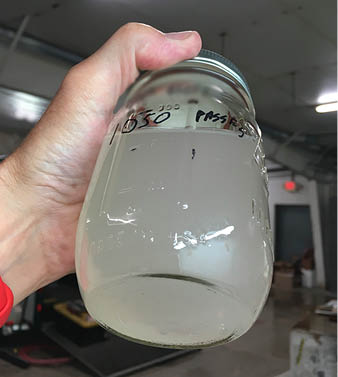
Results of sample evaluations
Throughout the process, wastewater used in the automatic scrubber was collected and evaluated.
During the 300th pass, a large amount of debris was found in the DIPs’ water. This indicates that the DIPs intended to maintain the floor were not only degrading its physical qualities but also the aesthetic qualities of the polished concrete surface.
The color of the DIPs’ wastewater sample was brown due to the dye used on the polished concrete several months before introducing the maintenance system. This suggests the maintenance system abraded the concrete surface enough to remove dye.
The CRA system produced virtually no debris in the wastewater sample collected after the 300th pass and again after 1,050 passes. The CRA sample’s water color wasn’t brown like that of the DIPs’ sample, indicating that the long-term use of CRAs is much safer for polished concrete than DIPs. Furthermore, the CRA section’s aesthetic qualities were significantly better than the DIPs’ section.
Rk values
Now let’s dig into the numbers to reflect a better understanding of what each product is doing to the surface. Regarding Rk values, a lower number indicates a smoother surface, while a higher number indicates a rougher surface. The higher the Rk value, the more scratches and abrasions on the surface.
At the start, the DIPs’ section of the polished concrete surface was measured at 34.98 Rk. The CRAs’ section was measured at 36.81 Rk. This indicates that even at the start of the testing, the CRAs’ surface was approximately two points higher (rougher) than the DIPs’ section. The following chart shows measurements throughout the test.
|
Number of |
CRAs |
DIPs |
|
100 |
26.39 |
49.87 |
|
200 |
19.05 |
64.80 |
|
400 |
19.06 |
64.51 |
|
600 |
17.86 |
71.18 |
|
800 |
16.85 |
81.02 |
|
1,000 |
16.62 |
85.42 |
As you can see, the DIPs increased the Rk values on each successive pass, while the CRAs decreased the Rk values. After 1,000 passes, the CRAs’ section was far lower/smoother (16.62 Rk) than the DIP section (85.42 Rk). This better explains why there was color and aggregate in the DIPs’ wastewater samples. Each DIPs’ pass further scratched and abraded the polished concrete surface.
DOI values
Regarding DOI values, the higher the number the better (DOI measures reflected image quality/clarity). The scale runs 0-100 and the closer to 100 the more mirror-like the surface becomes. The DIPs’ section of the test area started at a 72.9 DOI reading. The CRAs’ section started at a 67.07. The following chart shows the progress of each system’s DOI readings over 1,000 passes.
As the study shows, even after only 100 passes, the aesthetic quality of the polished concrete surface maintained with DIPs depreciated by 34.4 percent. In comparison, the CRAs increased their DOI readings by 27.3 percent over the course of 100 passes, indicating that it’s improving the surface’s aesthetic quality over time.
|
Number of |
CRAs |
DIPs |
|
100 |
85.42 |
47.77 |
|
200 |
87.81 |
41.50 |
|
300 |
87.50 |
41.09 |
|
400 |
88.27 |
43.35 |
|
500 |
87.93 |
38.00 |
|
600 |
88.12 |
39.08 |
|
800 |
86.20 |
37.10 |
|
1,000 |
84.20 |
33.06 |
The test speaks for itself when it comes to aesthetic qualities of a polished concrete surface: the CRAs method is far superior to DIPs.
In conclusion
This study reveals that since new technologies such as CRAs have emerged, there’s a maintenance method that provides polished concrete surfaces with far better results than DIPs.
It should be noted that DIPs are doing more harm than good when speaking in terms of polished concrete’s physical and aesthetic qualities, which essentially defeats the purpose of using it as a daily or weekly cleaning pad.
With the integrity of someone’s job/work at stake, we all want to provide them with a maintenance solution that will keep them proud to return to the job site years later. Choosing CRAs should be a concrete contractor’s first choice when recommending a long-term maintenance solution.
As many of us know, cost can be a driving factor when it comes to maintenance systems. While some systems seemingly have a good price tag, it’s more important to pay attention to what your price per square foot is going to be.
Oftentimes when the price tag seems affordable, the price per square foot will reveal how expensive the product truly is. It is equally important to know what your maintenance system is doing to a floor. If a polished concrete floor is being ruined by a cheap maintenance system, it will ultimately cost you more in the long run!

